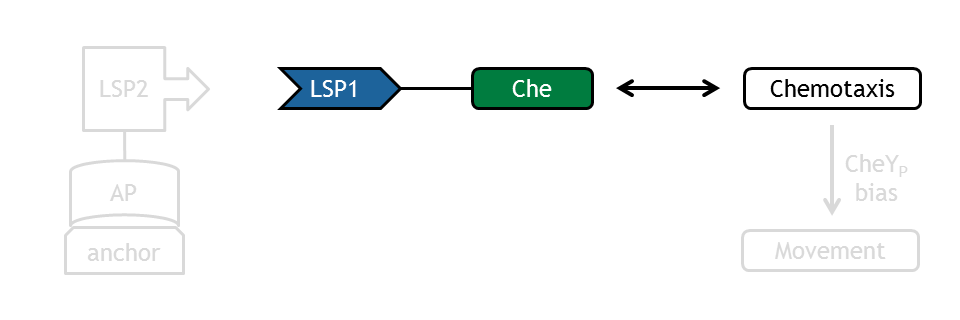Team:ETHZ Basel/Modeling/Chemotaxis
From 2010.igem.org
| Line 34: | Line 34: | ||
[2] [http://www.cell.com/biophysj/retrieve/pii/S0006349503700216 Mello et al: Perfect and Near-Perfect Adaptation in a Model of Bacterial Chemotaxis. Biophysical Journal 2003 84;5;2943-2956.] | [2] [http://www.cell.com/biophysj/retrieve/pii/S0006349503700216 Mello et al: Perfect and Near-Perfect Adaptation in a Model of Bacterial Chemotaxis. Biophysical Journal 2003 84;5;2943-2956.] | ||
| - | [3] [http://www. | + | [3] [http://www.plosbiology.org/article/info:doi/10.1371/journal.pbio.0020049 Rao et al: Design and Diversity in Bacterial Chemotaxis: A Comparative Study in Escherichia coli and Bacillus subtilis. PLoS Biol 2004;2;2;239-252] |
[4] [http://www.cell.com/biophysj/retrieve/pii/S0006349503700216 Mello et al: Perfect and Near-Perfect Adaptation in a Model of Bacterial Chemotaxis. Biophysical Journal 2003 84;5;2943-2956.] | [4] [http://www.cell.com/biophysj/retrieve/pii/S0006349503700216 Mello et al: Perfect and Near-Perfect Adaptation in a Model of Bacterial Chemotaxis. Biophysical Journal 2003 84;5;2943-2956.] | ||
Revision as of 14:40, 22 September 2010
Modeling of the chemotaxis receptor pathway
The chemotaxis receptor pathway in E. coli is quite complex. Published models of chemotaxis [1], [2], [3], [4] thus have to make many assumptions in order to suit the question of the investigation. It was therefore decided to implement four different models to be able to achieve a more general consensus prediction of chemotaxis behavior in E. lemming.
For the combined model implementation, only two chemotaxis models have been further investigated: Spiro [1] and Mello [2].
Implementation
Spiro et al. (1997)
This model basically predicts that for all Che proteins (CheR, B, Y and Z) would make a good light input. For CheR and CheY the concentration of CheYp drops more than Delta (initial value - Threshold), for CheB and CheZ it increases more than Delta. For all Che proteins the concentrations stay like forever below/above the Threshold, until we deactivate them with far-red light. The best results was obtained for assuming a high ligand concentration (saturation, so that the methylation level of the receptors is high). For CheY and CheZ the reaction times were (as expected), much faster than for CheB and CheR. However, for these proteins the reaction times were still fast enough.
Mello et al. (2003)
This model is already implemented compatible to the Spiro1997 model, but not yet documented.
Rao et al. (2004)
This model predicts quite a similar behavior of the Che proteins, as demonstrated by the previous model. A notable difference is that the response of CheYp level to the change of the level of the other Che proteins is robust to the fluctuations of the ligand (attractant) concentration. In the previous model (Spiro), the most desirable results were obtained only for higher concentrations of the ligand.
A detailed analysis of the simulation results obtained from this model can be found here.
Barkai & Leibler (1997)
The model is implemented, but not yet documented.
References
[1] [http://www.pnas.org/content/94/14/7263.full Spiro et al: A model of excitation and adaptation in bacterial chemotaxis. PNAS 1997 94;14;7263-7268.]
[2] [http://www.cell.com/biophysj/retrieve/pii/S0006349503700216 Mello et al: Perfect and Near-Perfect Adaptation in a Model of Bacterial Chemotaxis. Biophysical Journal 2003 84;5;2943-2956.]
[3] [http://www.plosbiology.org/article/info:doi/10.1371/journal.pbio.0020049 Rao et al: Design and Diversity in Bacterial Chemotaxis: A Comparative Study in Escherichia coli and Bacillus subtilis. PLoS Biol 2004;2;2;239-252]
[4] [http://www.cell.com/biophysj/retrieve/pii/S0006349503700216 Mello et al: Perfect and Near-Perfect Adaptation in a Model of Bacterial Chemotaxis. Biophysical Journal 2003 84;5;2943-2956.]
 "
"



